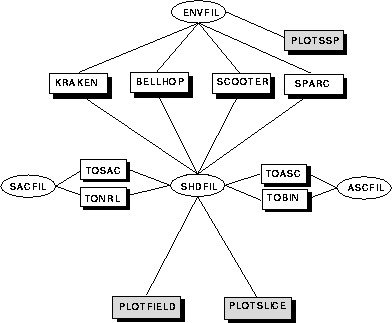
Figure: Structure of the Acoustics Toolbox.
The KRAKEN program is actually part of a complete package of modeling tools referred to as the Acoustics Toolbox and structured as shown in Fig. 4.1. Besides the KRAKEN normal mode model, there is also a 1) ray/beam tracing model, BELLHOP , 2) an FFP (spectral integral), SCOOTER , and 3) a time-domain FFP model, SPARC .

Figure: Structure of the Acoustics Toolbox.
The models take as input a user-provided environmental file (ENVFIL) to describe the problem. This file has the same format for all models. PLOTSSP can be used to produce a plot of the sound speed profile defined in the environmental file.
The models then produce a binary `shade' file (SHDFIL) that contains calculated pressure fields. PLOTFIELD can be used to convert the pressure to transmission loss and produce a color or grey shade plot of the transmission loss over range and depth. The program PLOTSLICE is used to plot a slice of the field along a fixed receiver depth. Additional programs exist for using the shade files to do matched-field processing, to compute a probability of detection or a radius of detection.
There are utilities available for converting between the NRL shade file format and the SACLANTCEN format (TONRL and TOSAC). This allows the SACLANTCEN models to be plotted using PLOTFIELD and PLOTSLICE for intermodel comparisons. There are also utilities for converting the shade file to an ASCII format (TOASC) and back to their original binary format (TOBIN). These programs allow you to transfer files between computers with incompatible binary files by transferring an ASCII file instead.
While the basic structure is as shown in Fig. 4.1, each of the models has additional plotting routines which are unique to it. For instance, the BELLHOP ray model produces rays and so it has a ray plotting program, while the KRAKEN normal mode produces modes and so it has a mode plotting program. In this chapter, we focus on the description of the KRAKEN component, however, the other models are also discussed (briefly).
Most of the development work has been done on a VAX using VMS Fortran but careful thought has been given to portability. The following changes are necessary to run KRAKEN under UNIX using the f77 compiler: